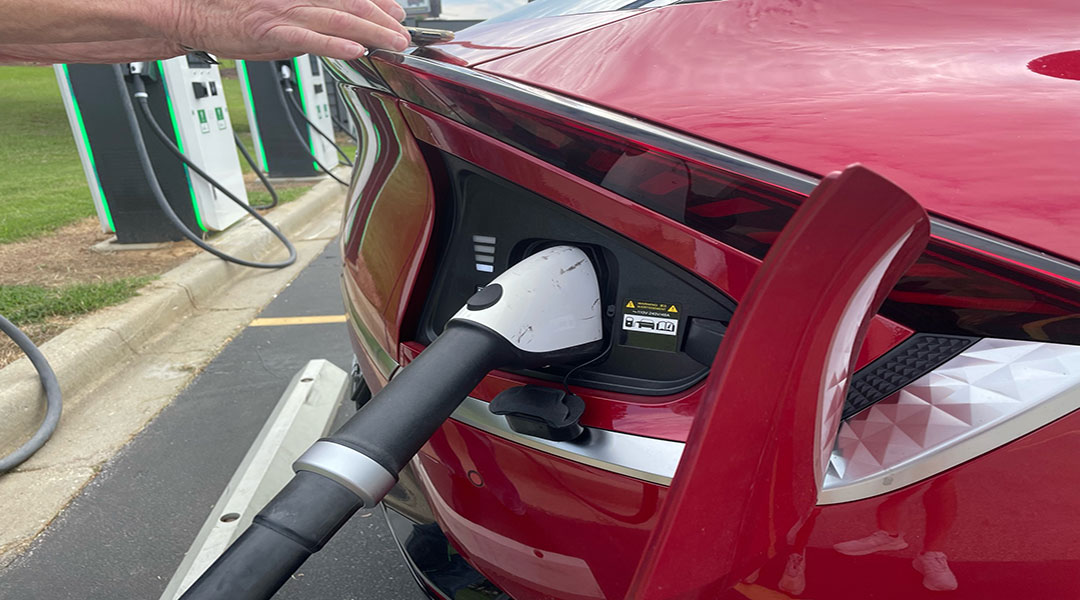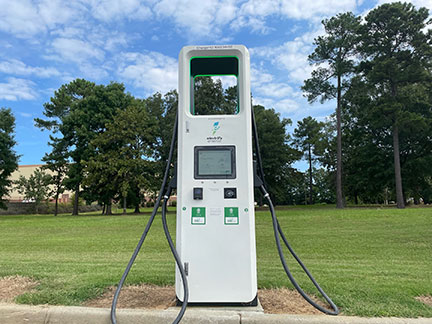An electric vehicle charging on Harrison Blvd. Photo by Holly Poag
As electric vehicles become more common on South Carolina roads, some local fire departments are planning how to respond to electric vehicle fires, while other departments, including the Columbia Fire Department, do not have official protocols in place.
Electric vehicle fires require different fire fighting techniques than fires in gasoline and diesel-powered cars, according to electric vehicle industry sources and local fire officials.
Fires in electric vehicles are put out using more water than a first responder would use for a vehicle that uses gasoline, according to the National Fire Protection Agency. To put out a battery fire, 3,000 to 8,000 gallons of water are needed, compared to only 300 gallons of water normally used for a gas-powered vehicle, according to a First Responder’s Guide from Tesla.
The Columbia Fire Department said it has strategies to tackle EV battery fires, such as using steam to cool batteries and applying water to other burning areas of the car, according to Columbia Fire Department Public Information Officer Mike DeSumma. However, there are no specific policies for electric vehicle fires, he added. He cited the novelty of electric vehicles as the main reason.
“We don’t categorize vehicle fires,” DeSumma said. “We just treat them as fires.”
Irmo’s firefighters are trained to allow the battery to burn until it self-extinguishes, according to Irmo Fire Chief Mike Sonefield. The department calls these fires “runaway batteries,” and will drag batteries off the road to a safe place for them to burn.
The National Fire Protection Agency recommends pulling batteries out and soaking them in salt water to discharge the energy within.
Columbia and Irmo fire departments have not documented any electric vehicle fires. However, Irmo Fire Chief Mike Sonefield expects a recently installed charging station in the Harbison area to raise the risk of EV fires in the Midlands because, he said, most electric vehicle fires happen when the car is charging. Early data suggests this is true, but some experts caution the industry is too new for reliable conclusions from such data.
Sonefield said he believes his department is ready to respond to the potential problem.
“We’re going to a lot of other fire departments to learn [about electric vehicle fire safety],” Sonefield said. “We train annually.”
Electric vehicles are becoming more common, with sales hitting 20,000 in the Southeastern United States in Quarter 2 of 2021, a 25% increase from the previous quarter, according to data from the Southern Alliance for Clean Energy and Atlas Public Policy.
An infrastructure bill passed by Congress and signed by President Biden in November includes $7.5 billion to build 500,000 electric vehicle chargers — like the one recently installed in the Harbison area — across the nation between 2022 and 2026, according to the Federal Highway Administration website.
There were 155 electric vehicles in Richland County, 87 in Lexington County and 11 in Kershaw County in 2018, according to data from the South Carolina Department of Energy.
Despite the increasing numbers of electric cars on the road, studies show that 31% of fire departments in the United States have said they do not train for electric vehicle fires. 50% of fire departments said they don’t have special protocols to handle electric vehicles after an accident, according to the National Transportation Safety Board.
“If I was in the East Coast and had concerns from a regulatory agency or a fire department, I would contact the Los Angeles or San Francisco or Oakland fire department,” Marc Geller, a board member of the Electric Auto Association and the co-founder of Plug In America, said. “Absolutely work has been done and there are procedures, because the fires are obviously different. San Francisco and Los Angeles have had to do it first, and they’ve had to do it for real.”
While there is a lack of training for electric vehicle battery fires around the Midlands, statistics suggest that the risk of an electric vehicle catching on fire is a fraction of its gas-powered counterpart.
Traditional gas-powered engine fires are 405.5 times more likely to occur than electric vehicle fires, according to 2018 statistics–the most recent available–from the National Fire Protection Agency and Tesla.
Lithium-ion batteries used in electric vehicles are similarly or less flammable than gasoline, according to a study conducted by the National Highway Traffic Safety Administration and General Motors in 2017.
Geller compared driving gas-powered cars to “driving down the road in Molotov cocktails.”
To solve the issue of electric vehicle fires, manufacturers such as General Motors, Ford and BMW are investing billions of dollars in developing next-generation batteries that are less likely to catch fire, according to their respective websites.
“The name of the game is electrification,” Geller said. “Anything we don’t use electricity for, most of those things can be moved to electricity. There’s ultimately savings and a clearly lower environmental impact.”
ABOUT THE JOURNALISTS

Holly Poag
Poag is a senior journalism student at the University of South Carolina. She has investigated the controversial redevelopment of Columbia’s BullStreet district while working for The State newspaper and The Daily Gamecock. She grew up in Sumter, S.C., and enjoys collecting houseplants in her limited free time.

Caleb Bozard
Bozard is a senior journalism student at the University of South Carolina and is a news editor at the student-run Daily Gamecock. He has covered topics such as university politics and social issues. He investigated anti-Asian and Asian American racism on campus during the COVID-19 pandemic and covered leaked, racially charged and homphobic student government communications. He recently interned for the Orangeburg Times and Democrat and is a first generation college student from Barnwell, S.C.




